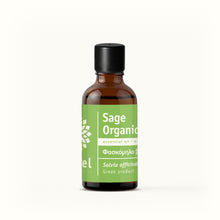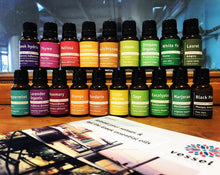Greek Sage (Salvia officinalis) Organic Essential Oil ct Alpha-thujone
Regular price
€9.60
Sale
If you are interested in buying larger size quantities we would love to receive your email at info@vessel.gr
Greek Organic Sage (Salvia officinalis) Essential Oil ct Alpha-thujone
Batch: E1001932
Our finest Greek Sage Essential Oil ready to be yours!



SAGE
This essential oil should not be confused with Clary Sage (Salvia sclarea) – they vary greatly in their composition and safety. Always ensure you check carefully what you are purchasing and how to use the oil safely.
Common name: Sage Dalmatian, common sage
Latin name: Salvia officinalis
Botanical family:Lamiaceae (Labiatae)
Method of extraction:steamdistillation
Plant part used to extract the oil:flowering tops and leaves
Cultivation method: organic farming
Area of origin: Central Macedonia, Greece
Historical notes:
Sage has been known and widely used by the Greeks and Romans since ancient times. Some of the uses included: warding off evil, snakebites, increasing women's fertility, and others.
Greek botanist Theophrastus (c. 371 – c. 287 BC), wrote about two different types of sage, a wild shrubby plant (‘sphakos’), and a similar cultivated plant (‘elelisphakos’).
Dioscorides (c. 40–90 AD), Greek physician, pharmacologist, botanist, and author of ‘De materia medica’- a 5-volume Greek pharmacopoeia about herbal medicine and related medicinal substances -recommended sage as a remedy with a diuretic, haemostatic, emmenagogue, and tonic properties. Similar recommendations were found in the works of Galen (129 – c. 216 AD), a Greek physician, surgeon and philosopher in the Roman Empire.
Over the centuries, sage was also used in various preparations for hair care, insect bites, nervous conditions, in oral preparations for inflammation of the mouth, tongue and throat, and to reduce fevers.
Biochemical group: ketone
Main chemical constituents: α-thujone, camphor, 1,8-cineole, β-thujone, camphene, α-humulene, α-pinene, β-caryophyllene, limonene, borneol, borneol acetate, β-pinene, para-cymene, β-myrcene, others
Colour: clear to pale yellow
Consistency: medium
Aroma strength: strong
Perfumery note: middle
Aroma: pungent, herbaceous, medicinal, camphorous, fresh, warm
Traditional Aromatherapy Uses:
Traditionally in aromatherapy treatments sageessential oil is associated with the following therapeutic properties: antibacterial, anti-inflammatory, antimicrobial,antiseptic, antispasmodic, astringent, anti-viral,carminative,digestive tonic,diuretic, emmenagogue,febrifuge, hypertensive, insecticidal, expectorant, immune-support, mucolytic, stimulant, stomachic, tonic, vulnerary
Qualified aromatherapists may use sage essential oil for common complaints such as:
Muscular aches and pains, joints, headaches, digestive upsets, sore throat, menstrual cramping, nervousness, mental fatigue, emotional exhaustion, memory loss, acne
- reproductive system – menstrual cramps, delayed and scanty menstruation, menopause problems
- digestive system – loss of appetite
- nervous system – nervous debility
- skin care – slow healing wounds
- others
How we use it:
Potential uses:
- For muscular aches and pains it might be blended with a couple of essential oils from the following: black pepper, ginger, lavender, sweet marjoram, peppermint or rosemaryFor
- For slow healing wounds consider combining with our helichrysum, carrot seed or lavender.
Please, also see our How to Use Essential Oils Safely page for more information
Safety considerations:
Essential oils with high thujone content should be used with great caution. It can cause skin irritation, using in bath is best avoided.
Tisserand and Young warn of the neurotoxicity of the sage oil. It should be avoided in pregnancy and breastfeeding. Maximum dermal use level is 0.4%
Reading Tisserand and Young's full profile is recommended. [Robert Tisserand and Rodney Young, 'Essential Oil Safety' (Second Edition. United Kingdom: Churchill Livingstone Elsevier, 2014), 414.]
Please, also see our How to Use Essential Oils Safely page for more information.
Research and studies:
- Salvia officinalis essential oil: Chemical analysis and evaluation of anti-enzymatic and antioxidant bioactivities
https://www.sciencedirect.com/science/article/pii/S0254629917316885
- Composition of the essential oil of Salvia officinalis L. from various European countries
- Chemical composition of Salvia officinalis l. essential oilfrom Bulgaria





